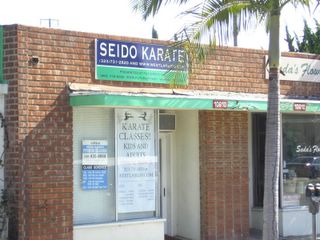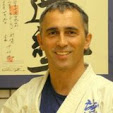
Flower Among Stones

Do the do!
We are embarking upon a new year. As usual, some of us will make "resolutions." There isn't anything wrong with setting goals for the year. It's actually a good idea. It may help focus the energy we bring to life.
A karateka may be excused if he or she makes only one resolution for the coming year: More training! This is an appropriate and acheiveable goal. Besides, it's the only way to go.
Recently an article in the Los Angeles Times reported on the upsurge of interest in and legal sanctions for Mixed Martial Arts (MMA) in California. People interviewed in the article were full of enthusiasm for the sport. It had been outlawed for a time in California but due to the bright commercial performance of MMA in other states, such as Nevada, and because of some changes made in the rules to restrict the more brutal aspects of the fighting, California has decided to permit MMA events within the state. Words such as "awesome," "adrenaline rush" and "real deal" were used by those interviewed for the article.
There's no denying that MMA is quite a spectacle. On the positive side, the sport has brought innovative talent to the "fight game." Extremely skillful fighters match themselves against each other within the "octagon." There is nothing extraneous about the fights. Having viewed many of these bouts on DVD or cable, I can attest to the high level of skill and conditioning exhibited by the athletes. On the negative side, however, MMA suggests that the only purpose of practicing a martial art is to learn how to fight.
The seeming antagonism between those who practice martial arts for spiritual or personal development and those who practice for the purpose of self-protection or fighting skill has existed for centuries. In Japan prior to the 16th century, bujutsu, or martial arts, were used almost exclusively for the purposes of military battle. Professional soldiers, samurai, trained for the event of war. And war abounded within Japan at that time. With the rise of the Tokugawa shogunate, however, civil war within Japan abated. The Tokugawa clan cleverly solidified its position as supreme ruler over the various lords, or daimyo, throughout feudal Japan and over the following two centuries military conflict within Japan abated.
With the cessation of conflict, samurai were left with little to do. The Tokugawa clan, aware of the dangers presented by an idle but well-trained class of soldiers, issued a series of pronouncements that served to change the emphasis among the samurai from combative to literary and aesthetic pursuits. Miyamoto Musashi, the famed swordsman, reflected this change of emphasis in his own development. A fierce assasin in his youth, Musashi became much more subtle in his maturity and eschewed the ethic of murder. The sword, the soul of the samurai, became a vehicle for spiritual insight and bujutsu, martial arts, was transformed to budo, martial ways.
The objective of budo is self-perfection, not self-protection. Like all spiritual practices, its "project" is to obliterate the boundary between ego and spirit. By harmonizing the small self with the ryhthms of the natural world, the individual gains access to a new understanding of life. This new understanding is not an intellectual, abstract one but arises out of experience. The method for obtaining experience is training. The sword is used not for delivering death but, rather, for defeating self-delusion and the dissatisfaction with life that arises from those delusions.
The process of a do form, as opposed to a jutsu form, calls for internal growth. It isn't enough to progress in terms of technique, though improving one's technique is certainly part of the process. In a do form, however, more emphasis is placed on the development of one's intuition. The arc of development follows through three distinct phases.
The first phase is gyo. This is the "blood, sweat and tears" phase of growth, to quote Donn Draeger in his excellent book, Classical Budo, Volume II. The gyo phase introduces the trainee to the dojo, the training area. The dojo is an austere, humble place of natural and quiet dignity. Always cleanliness and order predominate. Spirituality pervades the atmosphere of the dojo and is physically centered on the shinzen. The trainee intuitively develops the right state of mind during training through the subtle inflence of the shinzen. The trainee must be humble. He or she must exhibit nyuman-shin, or "soft-heartedness," a certain flexibility of spirit that attests to a readiness to accept things as they are presented to him or her. Training is a painful process of trial and error, of plodding with little explanation in a complex mire of technical difficulties. The trainee's questions are met by the teacher's laconic reply, "Don't ask, train!"
If the trainee embraces soft-heartedness and silence sufficiently, he or she then passes to the next phase, known as shugyo. Shugyo is a process of "seeking a way out of the dilemma." Before the trainee can make a good escape he or she must first drift around on a technical sea and may even suffer "technical shipwreck." The intensity of the trainee's search must now be strengthened by the force of his or her spirit, kokoro. Without spiritual energy focused in this manner, no do can be pursued. In overcoming the technical adversities the trainee begins to recognize "truth in action," chi gyo ichi nyo, and to understand it. In shugyo, as in gyo, repetition is the core training method. Exemplified in kata, these exercises serve to reinforce the lesson that motor skills are not to be learned by words but through action.
With their spiritual resolve connected unbreakably to practice, the trainee is ready for the third phase of growth, known as jutsu. Here the trainee feels an "unfinishedness" in their technique and is acutely aware of the need for pursuing technical perfection. The trainee at the jutsu level becomes more concerned with the possible combative significance in the techniques than with the idea that they are to be used for noncombative purposes with a finished artistic form. The great danger here is that of vanity. A trainee may feel they have accomplished a technical perfection that, if not challenged, will prevent progress toward the ultimate goal of self-mastery. Ego will dominate action and the state of "artless art" arising from intuition will forever be denied.
By "practice" and "mastery" the Japanese warrior understood certain very specific things. True practice only begins at the jutsu stage, where outward form has been mastered. It is at this stage that the real work begins - that of molding and finalizing the self. In classical budo training the aim of practice is not the visible, physical results but the inner development gained through experience and insight. The trainee must be made to realize that the goal cannot be aimed at technically. The warrior saying, "Katte, kabuto o o-shime yo!" - "After victory tighten your helmet cords!" - shows anticipation of harder tasks yet to come, and it is well that the trainee makes this his motto.
While the octagon of MMA presents a realistic version of sport fighting, it continues to give short shrift to the more lasting transformative process that comes from practicing a do form. Fighting in the octagon may indeed be an adrenaline rush, but life is lived in peaks and valleys and a reduction of life to mere motor skills will fail us in the more subtle arenas where most of life is lived. Without this more mature appreciation of life, bujutsu and the octagon are bereft of lasting value. The alternative to bujutsu is budo. Do the do!
Commit, believe, train! See you in the dojo. Osu.













